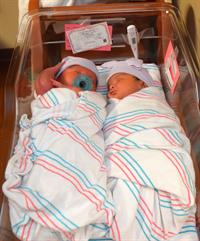

On a late August morning as Tropical Storm Harvey moved north of the Galveston County area, anyone would have excused Latasha Vernon if she was a bit cranky.
She had been in her hospital room in John Sealy Hospital for a week. She had no idea when she would finally be able to take her twin newborns home.
To top it off, her home in Bacliff had been flooded.
But instead of anger or annoyance, Vernon cooed happily over her less-than-week-old babies.
“The staff here is just really wonderful and they care so much,” Vernon said. “They can’t get over the twins. They want to cuddle them and hug them.”
When Vernon and her husband arrived at John Sealy Hospital on Aug. 24 for monitoring, they had no idea they’d be going home with their twins in their arms.
But like pregnancies, storms can be unpredictable.
Once Vernon arrived at the Galveston Campus, flooded roads made it impossible to go back home. What started as monitoring turned into a longer stay at the hospital. Then, even though it was still about a week before her predicted due date of Aug. 26, her doctor said it was time to deliver the babies.
The once-in-a-generation storm raging outside didn’t matter. On UTMB’s Galveston, League City and Angleton Danbury campuses, mothers still had to have their babies. UTMB nurses, doctors and other essential employees were there to make sure Vernon, and over 100 other mothers like her, were cared for.
“Delivery, once you are pregnant, is not an elective procedure,” said Deb Mordecai, director of patient care and assistant chief nursing officer for Women’s, Infants’ and Children’s Services at UTMB. “Babies must be delivered.”

In the approximately one week that UTMB was under emergency operations due to Harvey, 99 babies were born on the Galveston Campus, 19 at the League City Campus and another 10 at the Angleton Danbury Campus. UTMB also took in patients from other hospitals in the region, including several babies who had to be flown in from a Beaumont hospital.
All this was done while some of the worst flooding ever seen ravaged Southeast Texas. UTMB had prepared by calling in faculty and staff to each campus and by having women with planned inductions or C-sections come in early before the storm hit.
At the League City Hospital, faculty and staff found themselves on what amounted to an island during the worst of the storm. But even then, mothers needing to deliver continued to come in.
Some women got to the hospital in dump trucks, one in a garbage truck and some lost everything but what they brought with them, said Christine Varisco, a labor, delivery, recovery and postpartum nurse at the League City Hospital.
Varisco, like many other faculty and staff, was unable to leave the campus and could only talk to her husband and other family members over the phone as the flood waters rose. Still, she and her co-workers kept doing their best to help the mothers and keep them and their newborns safe.
“Taking care of the patients has been a little bright area in a very dark, dark storm,” Varisco said.
While patient safety and comfort were a priority, UTMB’s faculty and staff were going through their own roller coasters of emotions and tribulations.
Megan Sharpe, a nurse in the labor and delivery department in John Sealy Hospital, was frantic when her husband told her their house in Dickinson was flooding. He was at home with their four children—ranging from 4 months to 12 years old—while Sharpe cared for mothers and their babies.
“I just took a deep breath and said ‘OK, here we go. We have to do this because it’s not about us, it’s about our patients,’” Sharpe said.
With the help of her colleagues, Sharpe made it through her shift. Eventually her husband and children were rescued by the U.S. Coast Guard. She was reunited with her family two days later when relief nurses came in to replace staff.
Mordecai said an important part of the successful operation of the hospitals during the emergency was caring for the needs and morale of the employees, as well as the patients.
“The best way to support the patients is to support the staff who have to take care of them,” Mordecai said.
For Vernon, the mother of newborn twins, it made all the difference to have nurses who she could relate to and trade stories with about Harvey.
As the storm started to pass and the sky cleared, Vernon was ready to get back to her house and the rest of her family. Still, she said, she was amazed by the UTMB staff that cared for her and other mothers during the storm.
“I thought it was really amazing that a lot of nurses and doctors stayed here to make sure the patients were safe and taken care of,” Vernon said. “I know we felt like we were taken care of.”